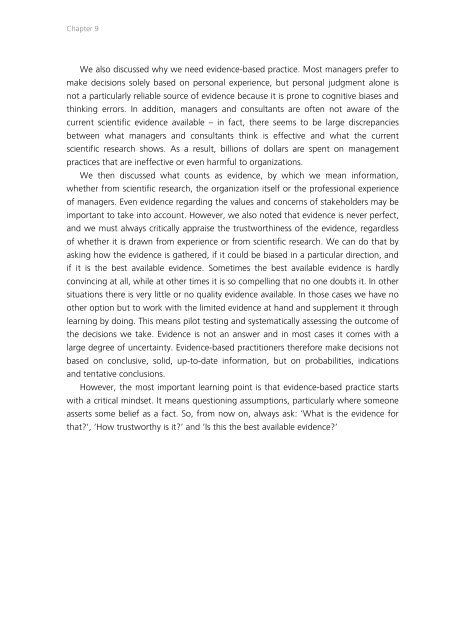In Search of Evidence
jqluvth
jqluvth
Create successful ePaper yourself
Turn your PDF publications into a flip-book with our unique Google optimized e-Paper software.
Chapter 9<br />
We also discussed why we need evidence-based practice. Most managers prefer to<br />
make decisions solely based on personal experience, but personal judgment alone is<br />
not a particularly reliable source <strong>of</strong> evidence because it is prone to cognitive biases and<br />
thinking errors. <strong>In</strong> addition, managers and consultants are <strong>of</strong>ten not aware <strong>of</strong> the<br />
current scientific evidence available — in fact, there seems to be large discrepancies<br />
between what managers and consultants think is effective and what the current<br />
scientific research shows. As a result, billions <strong>of</strong> dollars are spent on management<br />
practices that are ineffective or even harmful to organizations.<br />
We then discussed what counts as evidence, by which we mean information,<br />
whether from scientific research, the organization itself or the pr<strong>of</strong>essional experience<br />
<strong>of</strong> managers. Even evidence regarding the values and concerns <strong>of</strong> stakeholders may be<br />
important to take into account. However, we also noted that evidence is never perfect,<br />
and we must always critically appraise the trustworthiness <strong>of</strong> the evidence, regardless<br />
<strong>of</strong> whether it is drawn from experience or from scientific research. We can do that by<br />
asking how the evidence is gathered, if it could be biased in a particular direction, and<br />
if it is the best available evidence. Sometimes the best available evidence is hardly<br />
convincing at all, while at other times it is so compelling that no one doubts it. <strong>In</strong> other<br />
situations there is very little or no quality evidence available. <strong>In</strong> those cases we have no<br />
other option but to work with the limited evidence at hand and supplement it through<br />
learning by doing. This means pilot testing and systematically assessing the outcome <strong>of</strong><br />
the decisions we take. <strong>Evidence</strong> is not an answer and in most cases it comes with a<br />
large degree <strong>of</strong> uncertainty. <strong>Evidence</strong>-based practitioners therefore make decisions not<br />
based on conclusive, solid, up-to-date information, but on probabilities, indications<br />
and tentative conclusions.<br />
However, the most important learning point is that evidence-based practice starts<br />
with a critical mindset. It means questioning assumptions, particularly where someone<br />
asserts some belief as a fact. So, from now on, always ask: ‘What is the evidence for<br />
that?’, ‘How trustworthy is it?’ and ‘Is this the best available evidence?’


